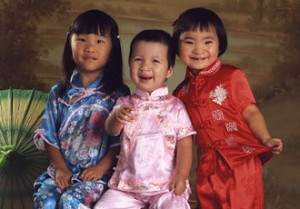Abortion rights advocates often challenge the viability of adoption as a solution to the problem of mothers who are unable or unwilling to parent their children after birth. Because many people are unacquainted with the information on adoption given below, they are prone to believe the doomsayers who predict millions of unwanted children wreaking havoc on society if abortion is banned. A quick look at some adoption statistics gives one a different sense of what an abortion-free future might look like.
CBR Director and Deputy Director (husband and wife) fight abortion through adoption. Our wonderful little daughters, Annie, Amy and Alice Cunningham, were abandoned at birth in China because they had cleft lip, cleft palate and other developmental defects. They are unbelievably smart and funny and very pro-life.
Adoption-Related Articles:
Fighting abortion issue, Christians turn to adoption – Conservatives open hearts and homes to foster children (The Dallas Morning News)
Loving Others’ Rejects – An elderly Chinese couple can always find room in their shack, and their hearts, for another castaway child — 42 of them in 17 years (Los Angeles Times)
Adoption Facts:
The following adoption facts were obtained from the National Council for Adoption (https://www.adoptioncouncil.org/)
- Babies, regardless of medical problems, who are “free for adoption,”generally do not wait long for families.
- There are waiting lists of couples who would like to adopt infants with Down Syndrome or Spina Bifida.
- The A K.I.D.S. Exchange reports that they have over 100 approved families waiting to adopt children with Down Syndrome.
- There are also a large number of couples who would like to adopt terminally ill babies, including babies with AIDS.
- ABC-TV’s “20/20” reported that they had received over 25,000 self-addressed stamped envelopes from individuals wanting to adopt Romanian orphans. Over 10,000 people contacted NCFA after Parade Magazine’s August 2, 1998, cover story on transracial adoption. (NCFA)
- There are between one and two million infertile and fertile couples and individuals who would like to adopt children.
- According to a survey by the National Council For Adoption (NCFA) there were 54,492 unrelated adoptions (adoptions by people not related to the child adopted) of American children in 1996. (NCFA)
- In addition, data from the Immigration and Naturalization Service and the U.S. Department of State indicate there were 17,000 foreign born children adopted by Americans in Fiscal Year 1999.
- International adoptions have been rising steadily from 6,536 in Fiscal Year 1992, the decade low-point, to the latest year, an all-time high. Additional adoptions by Americans may have taken place but not be counted in these numbers because the Americans adopted while living outside the U.S. (NCFA)
- Of the 54,492 unrelated domestic adoptions, approximately one half (23,537) were adoptions of healthy infants (under 2 years of age) of all races and ethnic backgrounds. The remaining were older kids and children with “special needs” (physical, mental, or emotional disabilities, part of a sibling group, etc.) (NCFA)
- Unrelated adoptions have fluctuated tremendously over the past three decades from 33,800 in 1951, to 61,600 in 1966, to a peak of 89,200 in 1970, declining to 47,700 in 1975, and then rising slightly to 50,720 in 1982, in 1986, 51,157,and in 1996, 54,492. (NCFA)
- State laws governing adoptions vary widely. In general, the birthparent(s) sign(s) a consent to the adoption or a relinquishment of parental rights. This consent or relinquishment is not legally binding prior to the birth of the child and can generally be revoked for a limited period of time after birth. The biological father of the child usually must be notified of any adoption plan, but procedures for this vary considerably. Separately, the prospective adoptive parents must file a petition to adopt. After a period of court supervision, usually six months to one year in length, during which the adoptive parents have custody of the child, the adoption is finalized. The adopted child then enjoys the legal footing in the family as a biological child. (NCFA)
- A 1982 study found that unmarried birth mothers who made adoption plans were more likely to continue their education, were more likely to marry subsequently, and were less likely to receive public assistance than birth mothers who chose to parent their child born out-of-wedlock. (Bachrach) These findings were confirmed in another study in 1988 which found that women who chose adoption for their children had an educational advantage, were more likely to delay marriage, were more likely to be employed and have a higher income, less likely to have a repeat out-of-wedlock pregnancy, and less likely to abort if they do have a repeat out-of-wedlock pregnancy. (McLaughlin, 1988)
- Adopted children enjoy more socio-economic advantages than children who remain with their unmarried birth mothers. They have better educated, older mothers, and they live in families with much higher incomes. (Bachrach, Marquis)
- Pregnant teens who received services that provided counseling and information on adoption to all clients were almost seven times more likely to choose adoption than those who received services from a program where adoption was not addressed. Also, when the parents of teens were included in services, pregnant teens were six times more likely to choose adoption than when they were not involved. Pregnant teens who were asked to compare their lives if they parented, with their lives if they chose adoption, were six times more likely to choose adoption than those who did not make the comparisons. Teens involved with teen pregnancy programs, which had teen parents talk with pregnant clients, were four times less likely to choose adoption then teens who did not meet with teen parents. The interventions described above were more dramatic for black teens than for white teens. Researchers believe the reason may be that black teens and their families have less opportunity to be exposed to information on adoption because of societal and counselor assumptions that black teens are not interested in adoption for their children. (McLaughlin, 1991)
- Only 1-2% of adopted adults “search” for their biological parents. (NCFA) A plan for adoption will be developed for approximately 22% of children entering the child welfare system. Therefore, there are about 110,000 children in the child welfare system who will be in need of adoptive families. The plan for the remaining 78% is for the children to return to their families or remain in long term foster care. (HHS)
- In 1999, the estimated median age of children adopted from the public welfare system was 6.4 years, but the median age of children waiting to be adopted was 7.8 years. Two years and 6 months was the median length of time that these children were waiting to be adopted in 1999. Most of the children waiting to be adopted had some sort of special need. (HHS, NCFA)
- State and federal adoption subsidy programs designed to assist parents with the costs of caring for a child with “special needs” are being paid to 81% of the children most recently adopted from the public foster care system. (HHS)



